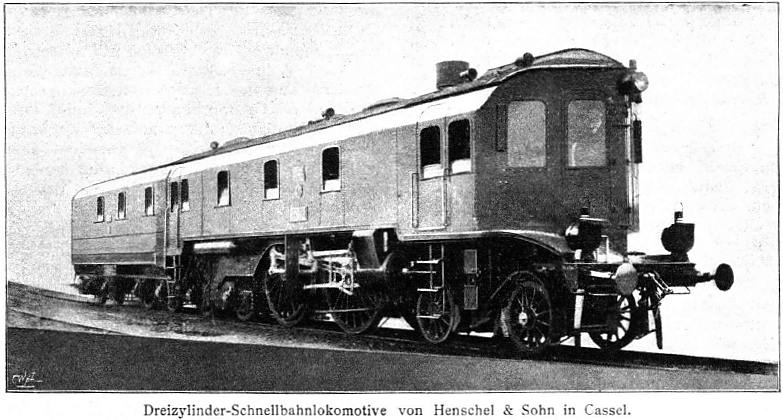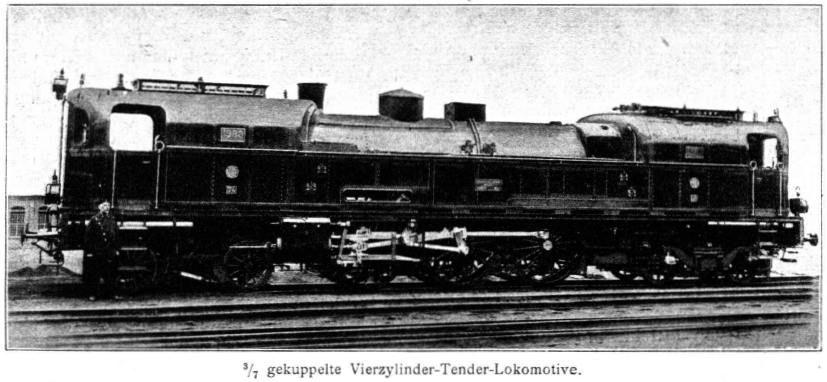Gallery opened: Jan 2003
Updated 12 Sept 2016
More info on S9 No 561




The Prussian State Railway Cabforward Locomotives |
Gallery opened: Jan 2003 |
Now, whether these qualify as true cabforwards is debateable. While they have a front cab, the rest of the locomotive is pointing in the usual direction; in most cabforwards the locomotive is reversed so that the firebox is at the front and the chimney at the rear.
THE PRUSSIAN S9: No 561
The S9's were built in 1904 by Henschel & Son of Cassel, at the suggestion of Dr von Wittfield, the director of the Prussian Ministry of Public Works. Most of the main controls were in the front cab, and the driver communicated with the fireman at the rear through a speaking tube; one wonders how well that worked in the noisy conditions of a steam locomotive. A third man was also carried, who relieved the fireman from time to time; when running backwards he occupied a control position at the rear from which he could operate the brakes or signal to the fireman or driver. There was a vestibule connection with the rest of the train.
 | Left: S9 No. 561
|
No 561 was a three-cylinder compound, with three cylinders of 524mm diameter and 630mm stroke. The inside HP cylinder was mounted horizontally above the leading bogie, and drove the leading driving axle. The two LP cylinders mounted outside drove the trailing driving axle. Walschaerts valvegear was fitted.
Empty weight77.5 tonnes
Working weight86 tonnes
Adhesion weight32 tonnes
Tender weight57 tonnes full
Water carried4400 gallons
Coal carried7 tonnes |
No 561 was shipped to America and shown at the Louisiana Purchase Exposition of 1904, but it appears no orders were forthcoming. Overall it cannot have been a great success, as it was converted into a conventional 4-4-4 in 1912. The need for a crew of three must have been a great economic disadvantage.
Information on No 561 from The Locomotive 15 Aug 1934.

THE PRUSSIAN S9: No 562
 | Left: S9 No. 562
|
 | Left: A fine model of No. 562 by the German company Westmodel |
The S9s were built to be high speed locomotives, but did not achieve more than 137 km/h (85 mph), perhaps because of their unconventional three cylinder compound design. Later the casing and the front cabs were removed, leaving them looking like strangely proportioned ordinary locomotives. They remained in service until 1918.
Additional S9 information kindly provided by Fritz Gallwitz.

THE PRUSSIAN S16
 | Left: No longer the only known photo of the T16
|
The loco was intended to appear at the 1904 world fair in St. Louis, USA but was not ready in time. In Germany, nobody wanted to buy the engine because of it's axle loading of 20 tons, so it was scrapped. It is not clear if this axle loading was deliberately aimed at the USA market, or if it was a miscalculation. It seems doubtful if Henschel really hoped to sell this kind of locomotive in the USA.
A more plausible account states that it was designed for the gradients in Thuringia in central Germany, to pull up to 200-ton trains at 75 km/h up slopes of 1%. It was one of the first tank locomotives (confusingly known in German as a Tenderlokomotive) with the wheel arrangement 4-6-4, designed for stable running characteristics in both directions at high speed; as a tank engine it would have been expected to work in both directions to eliminate the need for turning the locomotive.
The twin cab design meant that a third man had to be carried on the locomotive. The reason for this is at present somewhat obscure, but may be because regulations required two men working together to observe the signals. This feature would not have been popular with the railway authorities.
The heavy axle load of 20 tons meant that the locomotive only saw restricted use. It was returned to Henschel and scrapped. The name T16 was later applied to an 0-10-0 tank locomotive design.
 | |
Above: Side view of the T16. The number on the side of the front cab appears to be 1383
|
The T16 has a Wikipedia entry in German.
Additional T16 information most kindly provided by Fritz Gallwitz.
Bibliography: 'Rekordlokomotiven' (Record Locomotives) by Wilhelm Reuter.

  
|